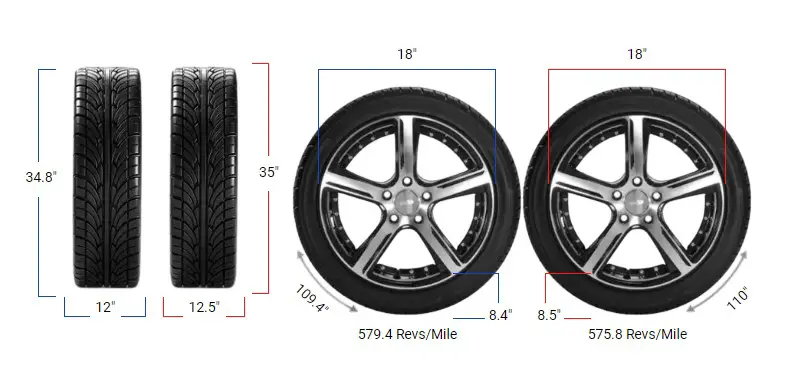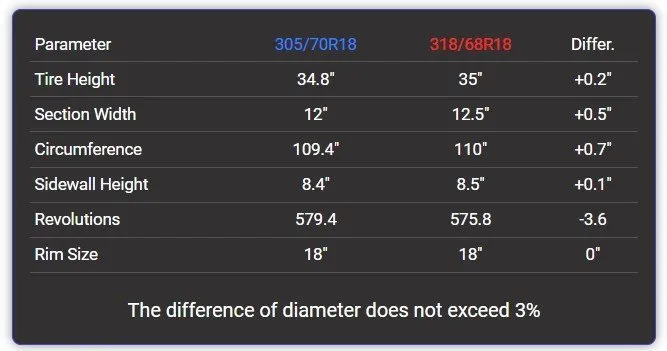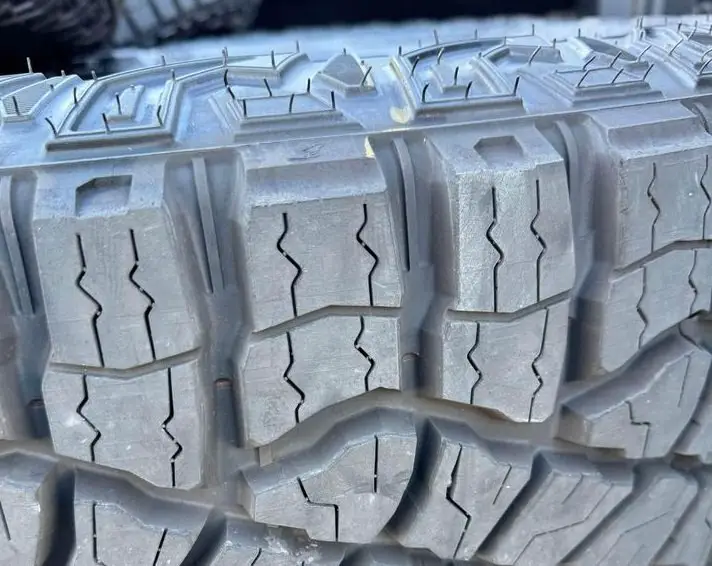Tire Size 305/70r18 vs 35×12.50r18

The primary difference between 305/70r18 and 35×12.50r18 tires lies in their width. The 35×12.50r18 is about 0.51 inches (13 mm) wider, which can provide a slightly larger footprint for improved traction.
This modest increase in width may require minor adjustments to prevent rubbing but generally won’t cause significant issues for most vehicles.
- Diameter increase is within the acceptable 3% range.
- Width increase may require minor adjustments.
- Minimal impact on speedometer accuracy and fuel efficiency.
- Slight improvement in ground clearance and off-road capability.
- Potential for minor rubbing issues in extreme steering situations.
305/70r18 vs 35×12.50r18 Table
This switch can provide some benefits for off-road use without significantly impacting on-road driving, making it a popular choice for those seeking a balance between daily driving and occasional off-road adventures.

Fitment Guide
It’s crucial to stay within the 3% diameter difference range. In this case, the 35×12.50r18 tires have a diameter of 35.03 inches, compared to the 305/70r18’s 34.81 inches.
This 0.22-inch difference represents a 0.6% increase, well within the acceptable range. Therefore, this interchange is recommended based on diameter considerations alone.
On-Road Impact
Switching to 35×12.50r18 tires will have some effects on your vehicle’s on-road performance, though most changes will be subtle. Let’s explore the various aspects affected by this tire change:
- Speedometer Accuracy: The slight increase in tire diameter will cause your speedometer to read slightly lower than your actual speed. At 20 mph, your true speed will be about 20.12 mph. This small difference is generally negligible in everyday driving but could add up over long distances.
- Fuel Efficiency: Larger tires typically result in a minor decrease in fuel efficiency due to increased rolling resistance and weight. However, the difference here is minimal, and most drivers won’t notice a significant change in their gas mileage.
- Ride Comfort: The wider tires may provide a slightly smoother ride on rough roads due to the increased air volume. However, the difference in sidewall height is only 0.11 inches, so the change in ride quality will be subtle at best.
- Handling: The wider tires offer a larger contact patch with the road, potentially improving grip in dry conditions. However, this may come at the cost of slightly reduced responsiveness in quick steering maneuvers due to the increased width and weight.
- Noise Levels: Depending on the specific tread pattern of the new tires, you might experience a slight increase in road noise. This is more related to the tire design than the size difference itself.

Off-Road Impact
For those who enjoy venturing off the beaten path, the switch to 35×12.50r18 tires can offer some advantages. Here’s how the change affects off-road performance:
- Ground Clearance: The new tires provide a modest increase in ground clearance of about 0.11 inches. While this might seem small, it can make a difference when navigating obstacles on trails.
- Traction: The wider tires offer a larger contact patch, which can translate to improved traction in loose terrain like sand, mud, or gravel. This extra grip can be particularly helpful in challenging off-road situations.
- Flotation: The increased width helps distribute the vehicle’s weight over a larger area, which can be beneficial when driving on soft surfaces like sand or snow.
- Rock Crawling: The slightly larger diameter can help with clearing larger rocks and obstacles, though the difference is minimal in this case.
- Water Fording: The small increase in overall diameter provides a negligible improvement in water fording depth.

What is the Difference Between 305/70r18 and 35×12.5r18?
The main difference between 305/70r18 and 35×12.5r18 tires lies in their width. The 35×12.5r18 tire is significantly wider, measuring 12.52 inches (318 mm) compared to the 305/70r18’s width of 12.01 inches (305 mm).
This 0.51-inch (13 mm) difference represents a 4.3% increase in width. The wider profile of the 35×12.5r18 tire provides a larger contact patch with the ground, which can improve traction and stability, especially in off-road conditions.
However, this width difference may require some adjustments to prevent rubbing issues on certain vehicles.
Can I Use 35×12.5r18 Instead of 305/70r18?
Yes, you can use 35×12.5r18 tires instead of 305/70r18 tires. The diameter difference between these two tire sizes is well within the recommended 3% range. The 35×12.5r18 tire has a diameter of 35.03 inches, while the 305/70r18 has a diameter of 34.81 inches.
This represents a difference of only 0.22 inches or 0.6%, which is well below the 3% threshold. This small difference ensures that the switch won’t significantly impact your vehicle’s performance, speedometer accuracy, or overall safety.

How Much Taller Is A 35×12.5r18 Tire Than A 305/70r18?
A 35×12.5r18 tire is slightly taller than a 305/70r18 tire. The difference in height is 0.22 inches (5.48 mm). The 35×12.5r18 tire has a diameter of 35.03 inches (889.68 mm), while the 305/70r18 tire has a diameter of 34.81 inches (884.2 mm).
This small increase in height results in a 0.6% difference in overall diameter, which is negligible for most practical purposes and falls well within the recommended 3% range for tire size changes.
How Much Wider is a 35×12.5r18 Tire Than a 305/70r18?
A 35×12.5r18 tire is 0.51 inches (13 mm) wider than a 305/70r18 tire. The 35×12.5r18 tire has a width of 12.52 inches (318 mm), while the 305/70r18 tire measures 12.01 inches (305 mm) in width.
This difference represents a 4.3% increase in width, which is more significant than the height difference.
The wider profile of the 35×12.5r18 tire provides a larger contact patch with the ground, potentially improving traction and stability, especially in off-road conditions.
Our Observation
Switching from 305/70r18 to 35×12.50r18 tires offers a balanced approach for those seeking minor improvements in off-road capability without significantly impacting daily on-road use.
The minimal increase in diameter ensures that speedometer accuracy and overall vehicle dynamics remain largely unchanged. The wider footprint provides a slight edge in off-road traction, which can be beneficial for occasional trail use.
However, the differences are subtle enough that most drivers won’t notice dramatic changes in either on-road or off-road performance.
This tire switch represents a safe and modest upgrade for those looking to enhance their vehicle’s versatility without making radical alterations.

Meet Caitlin McCormack, a Tire Size Expert and Blogger Passionate About Everything Related to Tires. With Years of Experience in the Tire Industry, Caitlin Has Become an Expert in Tire Sizes and Their Impact on Vehicle Performance.
